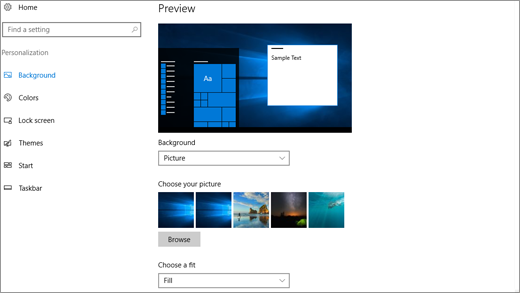
Introduction:
In the vast landscape of digital personalization, the desktop background serves as the canvas upon which users express their individuality and set the tone for their computing experience. Windows 10, with its array of customization options, allows users to transform their desktops into visual masterpieces. This comprehensive guide delves into the step-by-step process, advanced customization techniques, and creative tips on how to change your desktop background in Windows 10. As you embark on this journey, the digital realm becomes a reflection of your style, passions, and aesthetic preferences.
Understanding the Significance of Desktop Backgrounds:
- Visual Identity: The desktop background is a visual identity marker, offering a glimpse into the user’s personality, interests, or mood. It sets the tone for the entire computing experience.
- Aesthetic Appeal: A carefully chosen desktop background enhances the aesthetic appeal of your computer, transforming it from a utilitarian tool to a personalized space.
Exploring Desktop Background Settings: A Step-by-Step Guide:
- Access Personalization Settings: Begin by opening the Windows Settings. Click on the Start Menu and select the gear-shaped Settings icon. Alternatively, press
Windows key + Ito access Settings directly. - Navigate to Personalization: In the Settings window, navigate to the “Personalization” section. Here, you’ll find a plethora of customization options for your Windows 10 interface.
- Select Background Settings: Within the Personalization menu, click on “Background” from the left-hand sidebar. This opens the Background settings, where you can customize your desktop appearance.
- Choose a Background: Under the “Choose your background” section, you can select a background image from the dropdown menu. Choose from options like Picture, Solid color, or Slideshow.
- Select a Picture: If you choose the Picture option, you can select a specific image as your background. Click on “Browse” to navigate to the folder containing your desired image and select it.
- Set Solid Color: Opt for a Solid color background by choosing the color of your preference from the provided color palette. This is a simple and clean option for a minimalist desktop.
- Create a Slideshow: To create a dynamic desktop, choose the Slideshow option. Click on “Browse” to select a folder containing multiple images. You can customize slideshow settings, such as changing pictures at specific intervals.
- Adjust Picture Position: If you’ve chosen a static image, you can adjust its position on the screen using the “Choose a fit” dropdown menu. Options include Fill, Fit, Stretch, Tile, and Center.
- Preview and Save Changes: Preview your selected background by minimizing the Settings window. If satisfied, click on “Save changes” to apply the new desktop background.
Advanced Desktop Background Customization:
- Dynamic Wallpapers: Explore third-party applications or Windows Store apps that offer dynamic or live wallpapers. These wallpapers can change throughout the day or react to system events.
- Customizing Slideshow Settings: For slideshow backgrounds, customize settings such as picture change frequency, shuffle, and whether the slideshow should include pictures from subfolders.
Common Challenges and Solutions:
- Image Resolution Issues: Ensure that the chosen image has an appropriate resolution for your screen. Low-resolution images may appear pixelated, while high-resolution images can slow down performance.
- Slideshow Interruptions: Slideshow interruptions may occur if your system enters sleep mode or if power-saving settings are activated. Adjust power settings to prevent interruptions during slideshows.
Practical Applications and Benefits:
- Mood Enhancement: Changing your desktop background allows you to curate an environment that suits your mood, whether it’s a calming landscape, an inspiring quote, or vibrant artwork.
- Seasonal and Event Themes: Rotate desktop backgrounds based on seasons, holidays, or special events. This brings a touch of freshness and relevance to your digital space.
- Branding and Identity: For professionals, setting a company logo or a brand-related image as the desktop background reinforces identity and brand awareness.
Conclusion:
The art of changing your desktop background in Windows 10 is a delightful journey of self-expression and creativity. As you explore the myriad options, from static images to dynamic wallpapers, your desktop becomes a canvas waiting to be adorned with the colors of your personality and preferences. Personalization goes beyond aesthetics; it’s about creating an environment that resonates with you, inspiring creativity, boosting mood, and enhancing the overall computing experience. So, venture into the realm of desktop background customization, let your creativity soar, and transform your digital canvas into a reflection of your unique style and identity.